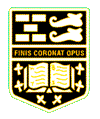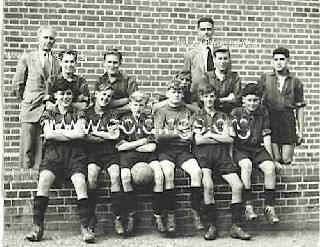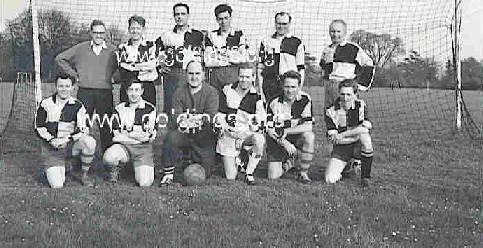|
Ron Stackwood worked for Barnardo's for forty-one very happy years. He lived in Waterford Parish for over twenty years,
first in the old laundry at Goldings and then in Goldings Lane. He retired in 1979 and went to live in Hertford.
"The Barnardo boys are coming."
Although I was only six years old in 1922 I can still remember my mother saying that to me. And off we went to witness
their arrival at the station. They marched out to Goldings, led by their own band, headed by a magnificent drum major
swinging his mace. The boys were all dressed in identical navy blue suits, the traditional winter dress for many years
afterwards. In summer the blue suits were changed to grey suits.
The William Baker Technical School, as it was called, was soon accepted as part of the community. As I grew up I had some
contact with the Barnardo's boys, especially when as a Scout I camped most week-ends in Mr Little's field at the top of
what is now Timber Orchard. A lot of the boys from the school broke bounds as they smelled sausages and bacon cooking
and came to join us. Later still I played football and cricket matches at Goldings.
My other contacts with people employed at the school were associated with Sundays. Several of my Sunday School and
Bible Class teachers at Christ Church, Bengeo, were members of staff at Goldings and one of them, Mr Woollen, was head
of the printing department. I am sure that neither of us ever dreamed I would one day hold the same job.
In 1938 I was employed as a Linotype operator on the Hertfordshire Mercury and I heard a rumour that the Linotype
instructor at Goldings was leaving. Employment then was on a par with that of today. Most printers were working a
two-day week and the future seemed bleak. So I wrote to the then Governor, the Rev. F.C. Macdonald, asking if there was
a vacancy. I was granted an interview and, in the first instance, was turned down as he considered that I was too young.
Being unmarried also weighed against me. Fate took a hand and I was later offered the job. Apparently the fact that I was
six feet four inches tall balanced out my other deficiencies. I still have the letter of appointment. The salary was to be £18 a
month. This included an extra payment for teaching two evening classes per week. It is interesting to note that the craft rate
for a printer in 1938 was £3.8s.6d. a week. It had stood at that figure for ten years and was to increase by only 7s a week by
the end of the war in 1945.
Life at the School was regulated from dawn to dusk by bugle calls: reveille, call to work, and calls for breaks, right through
to lights out. With a back garden of a hundred acres this was a most efficient method of communication. Workshops had
been built around the mansion and included some for boot makers, sheet metal workers, printers, carpenters, engineers,
and of course gardeners. General school work took place within the mansion.
The entire estate, including the workshops, relied on electricity supplied by a huge generator, housed in the engineer's
department. The method of ignition was to insert a large firework into a gas chamber and strike a flint... and away went
the generator. The current generated was 120 volts instead of the 240 volts supplied by the national grid.
The school curriculum was unique. With boys in the age range of 12-18 it had to be all embracing. The younger lads spent
most of their school-time at general subjects and each could choose three trades, attending for one half day a week. As they
grew older one trade would be dropped, and then, at 14 a firm choice would be made for the trade that hopefully was to
earn them a living. This system had much to commend it. It meant that a lad who opted for printing had also a very sound
knowledge of two other skills.
The school was a most useful resource for the Barnardo organisation. The boot makers, who could really make shoes,
Repaired countless pairs for Goldings boys, and every week a lorry load would arrive from other Barnardo establishments.
The carpenters made furniture for many homes and pews for chapels, as well as maintaining the fabric of the mansion,
workshops and staff houses. There was always plenty of work for the painters and decorators. The printers produced
advertising literature for events held by Barnardo Helpers' Leagues all over the British Isles, school magazines for all the
other large Barnardo establishments and stationery items for headquarters. The sheet metal workers always had a full
order book for kettles, watering cans and the host of domestic items needed in homes far and wide. There were also the
gardener trainees who supplied a great deal of fruit and vegetables throughout the year, the fruit, that is, that could be
protected from the scrumpers.
Proper supervision of some two hundred youngsters demanded a large staff. There were seventy in total. Instructional staff
were expected to help with out of school activities and out of workshop activities and this entailed one evening per week,
one lunch-time supervision period and one week-end duty, morning or afternoon once a month. No overtime was paid but
one day off per week was granted in lieu.
Spare-time activities for the boys included snooker/ billiards, art, table tennis, music, choir practice and, during the
summer months, cricket and swimming were most popular. School concerts and pantomimes were always guaranteed an
appreciative audience and the gymnasium was the stage for many an unexpected talent.
My association with the School lasted just one year as in 1939 Hitler upset the world, and as a Territorial in the Hertford
Battery of the Royal Artillery I was called up on the day war was declared and immediately my wages dropped to two
shillings (l0p) a day. We were allowed to draw 5p a day, the other 5p being put with a credit account on which to draw for
our leave periods.
Goldings set about becoming a fortress and huge slit trenches were excavated in the banks behind the mansion. Many of
the staff were drawn into the Home Guard, and the production of vegetables became a top priority. Of course, most of the
lads completing their training entered the forces instead of normal employment and quite a number died in action.
Upon my demobilisation in 1946 my old job was available. The machines had been removed to the ground floor as the
bombing had weakened the structure and the machines were in danger of moving to the ground floor anyway. The staff
and boys festooned the department with bunting and welcome back signs for my return.
The administration of the School had altered. Instead of a Governor in charge we now had a Headmaster, Mr R F Wheatley,
and all instructional staff with formal qualifications became qualified teachers. I had none but was placed on the Burnham
scale on the lowest rang, £400 a year at that time, and was told if I obtained my qualification my job was guaranteed. This
I managed to do.
In the late 1940s the then head of the printing department was able to institute a seven year apprenticeship for the boys in
the department. This ensured they would be accepted as craftsmen and by the trade unions at the end of their "time" as it
was known. It also meant that they left the school accommodation and moved into a hostel at The Verney in Waterford,
giving them a different status and more independence.
Following the war there were still many hindrances, not least being the shortage of electricity. The school generator was no
longer able to cope with the load and the national grid was at a low ebb. High penalties were imposed on heavy loads and
this meant the workshop machinery could not be used before 10.30 each morning. Evening classes became morning classes
when all the theoretical work would be done.
Although the staff numbers were high the boys were expected to do some chores, such as vegetable preparation in the
kitchen, and I suppose the most sought after job was in the Headmaster's pantry! The boys were also responsible for the
cleanliness of their own dormitories, and the wooden floor had to be polished.
The Headmaster was tireless in his efforts to have the School improved and in 1960 as a result of his efforts a new dormitory
wing was added to the rear of the mansion. Shortly afterwards a new wing was added to the printing department, enabling
us to install larger machinery and also provide better facilities for the theoretical work.
Perhaps what brought the greatest publicity to the School was the appearance of Goldings boys at the Wimbledon Tennis
Championships as ball boys. There was great excitement as all the boys trained for this event. They spent hours running at
speed and picking up tennis balls. It all looks quite easy on TV but much depends upon the speed about the court of the
ball boys and on clean pick ups. Two bus loads would leave the School each morning for the long journey to the courts.
On arrival the boys would change into the official shirt, shorts, socks and shoes, be allocated their courts and then have
lunch in a dining room reserved specially for them. One perk for the staff was to accompany the boys in supervisory
capacities. This meant, of course, access to the courts (to check that everything was going smoothly).
During the early 1960s Barnardo's pioneered a new child-care policy and a number of their large homes were closed in
favour of small family units. There was also a trend towards providing skilled help to families so that their children were
not taken into care. Rumours were rife and there was some unease as it was thought that Goldings was under threat.
However these doubts about the future were dispelled when, in 1965, a new educational block was built opposite the
gymnasium and at the same time a new detached art room was built along-side the path to the cricket field. With this
expansion undertaken it appeared that the school had a secure future.
Just two years later I was enjoying my day off when a note was delivered to me from the Headmaster, requesting that I
should attend a meeting to be addressed by Sir Arthur Smith, Chairman of Barnardo Council. As I set off that afternoon
to walk along the lime lined avenue to school my wife laughingly remarked, "I suppose he's come to close the school." She
was not laughing when I returned to tell her that she was right and that I, along with the rest of the staff, would be
redundant the following summer, and boys would not be returning after their summer holiday.
There were probably many factors which influenced the decision to close. From being a home for orphans, as it had been
when I joined the staff in 1938, it had become a haven for children from broken homes, many of them often delinquent or
else very close to delinquency. The costs of running such a large establishment were also rising enormously.
The period of grace between the announcement of closure and the actual date of closure did enable most of the staff to find
alternative employment but it seemed tragic that such a unique team with years of experience in child care had to be broken
up.
At that time I was head of the printing department, and, with twenty-five apprentices at various points in their apprenticeship,
faced the prospect of finding places in industry where they could complete their time. However it was decided that the
printing department would continue and a new school was built in Mead Lane, Hertford. It was known as the Barnardo
School of Printing. Goldings closed its doors in July 1967, but we continued to use the workshop there until we could move
into our new premises in 1969. They were very sad days.
There are hundreds of Goldings boys all over the world, most of them grateful for the training they received and for what
was probably the most stable period of their young lives. Two hundred or so regularly attend the reunions, travelling from
all over the British Isles and even from the Channel Isles and the Isle of Wight. One year at the dinner-dance they were
entertained by one of their contemporaries who appears on TV. He was known to them as Rastus Woods but his stage name
is Johnny Silvo. He is an accomplished country singer and very skilful guitarist. He spent all his leisure time at Goldings
strumming a guitar. GOLDINGS, 1997 (by May Bennett). Modern office buildings on right.
To those of you who knew Goldings in the years it was occupied by Barnardo boys I hope I've brought back a few memories.
To those of you new to the village I hope I've filled in a little of the local history.
By Ron Stackwood (1916-1993)
|



